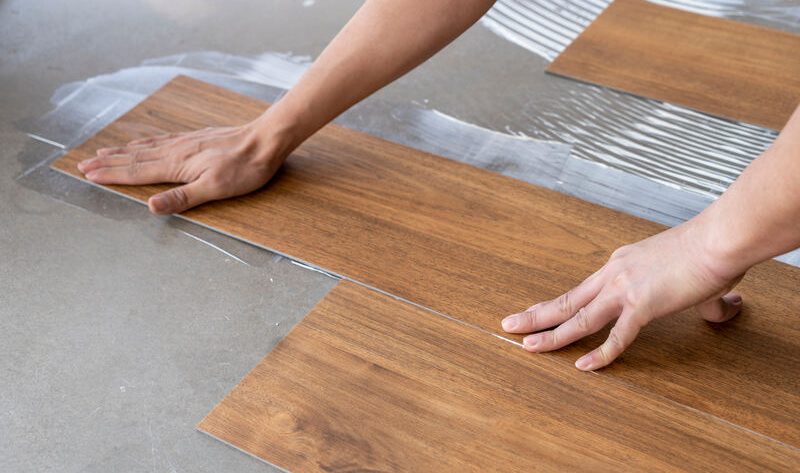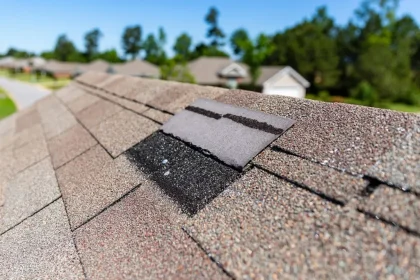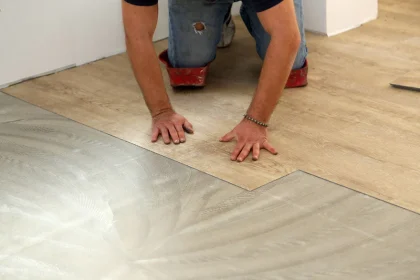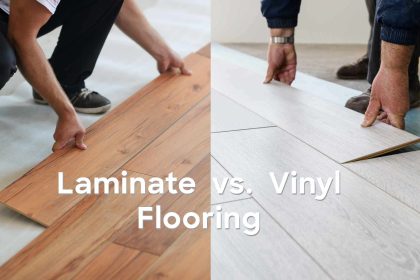Vinyl flooring continues to grow in popularity thanks to its durability, water resistance, and modern aesthetics. But if you’re considering this stylish flooring solution, one big question likely comes to mind: How much will it actually cost to install vinyl flooring in your home?
The answer isn’t one-size-fits-all. Pricing depends on the type of vinyl you choose, the condition of your subfloor, installation complexity, and even your location. This guide breaks it down so you know exactly what to expect before pulling out your wallet.
How Much Does Vinyl Flooring Cost Per Square Metre?
On average, vinyl flooring materials cost between £15 to £40 per square metre in the UK. Here’s a quick overview of price ranges by type:
- Sheet vinyl: £15–£25 per m² – budget-friendly and great for large areas
- Vinyl tiles: £20–£30 per m² – easier to replace and install
- Luxury Vinyl Plank (LVP): £25–£40 per m² – offers a premium, wood-like appearance
Luxury options, such as embossed or waterproof LVP, can go even higher—especially if you’re going for a well-known brand.
Installation Costs: Labour Isn’t Always Included
While some DIY-savvy homeowners install vinyl themselves, many opt for professional installation. Installation costs range from £10 to £30 per m², depending on the complexity.
Simple layouts on level concrete floors usually cost less, while installations over old flooring, uneven surfaces, or those involving intricate cutting (such as around toilets or cabinetry) will push the price up.
If you’re hiring a tradesperson, always ask for a detailed quote that separates material and labour costs. This clarity can prevent unexpected budget overruns.
Average Total Cost by Room Size
Let’s break this into practical estimates:
- Small bathroom (4 m²)
- Vinyl material: £80–£160
- Installation: £40–£120
- Total: £120–£280
- Medium kitchen (10 m²)
- Vinyl material: £150–£400
- Installation: £100–£300
- Total: £250–£700
- Large open-plan living room (25 m²)
- Vinyl material: £375–£1,000
- Installation: £250–£750
- Total: £625–£1,750
These figures will fluctuate if you opt for underlay, subfloor levelling, or removal of old flooring.
Factors That Affect the Total Cost of Vinyl Flooring and Installation
When calculating the total cost of vinyl flooring, several behind-the-scenes variables can significantly affect your final quote. Understanding these can help you make more informed decisions—and avoid unexpected expenses.
1. What Is the Role of Subfloor Condition in Vinyl Flooring Costs?
The condition of your subfloor can dramatically influence both installation complexity and price. If the subfloor is uneven, cracked, or damp, it needs preparation before vinyl flooring can be installed. This might involve:
- Levelling compound application (£5–£15 per m²)
- Moisture barriers if damp is present (adds ~£2–£5 per m²)
- Plywood boarding over poor concrete or timber bases
Why it matters: An uneven subfloor affects how vinyl sits, potentially shortening its lifespan. Installers may charge more if additional materials or time are needed to make the surface suitable.
2. Does Removing Old Flooring Increase the Installation Cost?
Yes. If you have existing tile, laminate, carpet, or hardwood, it must often be removed and disposed of, which is a separate labour task. Removal costs vary based on flooring type:
- Carpet: ~£3–£5 per m²
- Laminate or vinyl tile: ~£5–£7 per m²
- Ceramic tile: ~£6–£8 per m² (more labour-intensive)
You may also be charged disposal fees, especially if materials are non-recyclable.
Expert tip: If you’re handy, removing old flooring yourself can reduce labour charges—but always check if your subfloor can handle the new material.
3. Is Underlay Necessary with Vinyl Flooring?
Underlay isn’t always optional. While some vinyl flooring comes with a built-in underlay layer, many types—especially luxury vinyl plank (LVP)—require a separate one for sound insulation, cushioning, or moisture protection.
- Basic foam underlay: ~£2–£4 per m²
- Acoustic underlay: ~£4–£7 per m²
- Moisture-resistant underlay: ~£3–£5 per m²
Other accessories—such as transition strips, adhesives, and skirting boards—may add £50 to £150 depending on the layout and finish level.
4. How Does Location Affect Flooring Costs in the UK?
Labour costs are not consistent across the UK. Homeowners in major urban areas like London, Surrey, and Berkshire often pay 15–25% more for the same installation work than those in the Midlands or Northern England.
- London installation rate: ~£25–£30 per m²
- Midlands/North: ~£15–£22 per m²
Why it matters: Always request local quotes and compare at least 2–3 flooring contractors to ensure competitive pricing in your area.
5. Do Brand and Warranty Influence the Cost of Vinyl Flooring?
Yes—dramatically. Premium brands like Karndean, Amtico, or Moduleo command higher upfront costs due to their:
- Extended warranties (up to 30 years)
- Enhanced wear layers (0.5mm to 0.7mm for commercial-grade)
- Authentic wood or stone textures
- Enhanced scratch and water resistance
Expect to pay £35–£55 per m² for branded luxury vinyl, compared to £15–£25 for no-name alternatives.
Is Vinyl Worth the Investment?
Vinyl isn’t just about aesthetics—it’s also about functionality and maintenance. It’s water-resistant, low-maintenance, and great for homes with pets or kids. When properly installed, vinyl can last 10–20 years, especially LVP options with protective coatings.
Some homeowners are drawn to cheaper alternatives, but going too low-budget often means compromising on quality, appearance, and longevity. It’s better to think of vinyl as a mid-range investment with high everyday value.
Long-Term Costs: Maintenance and Repair
Vinyl is generally low-maintenance. A simple sweep and occasional mop will do. Unlike wood or laminate, it doesn’t require sealing or polishing.
- Minor repairs (like replacing a damaged tile or plank): ~£50–£100
- Full floor replacement (if improperly installed or flooded): Costly—highlighting the value of professional fitting.
Comparing Vinyl to Other Flooring Types
| Flooring Type | Average Cost per m² | Installation Ease | Water Resistance | Lifespan |
|---|---|---|---|---|
| Vinyl (LVP/sheet) | £15–£40 | Easy | Excellent | 10–20 years |
| Laminate | £10–£35 | Moderate | Fair | 10–15 years |
| Hardwood | £40–£100+ | Difficult | Poor (unless sealed) | 20–50 years |
| Ceramic Tile | £25–£60 | Difficult | Excellent | 20+ years |
Vinyl often wins in cost-effectiveness, especially for kitchens, bathrooms, and rentals.
Final Tips to Save Without Compromising
- Buy in bulk: Especially useful for larger spaces—suppliers may offer 5–10% discounts.
- Choose mid-range brands: You often get the best blend of quality and value.
- Ask about offcuts: For small areas, leftover cuts from other jobs may be available at reduced rates.
- Schedule off-season: Contractors may offer lower rates during slower months.
By knowing what to expect from vinyl flooring and installation costs, you’ll be better prepared to plan your budget—and avoid hidden fees. Whether you’re remodelling your kitchen or replacing tired flooring in a hallway, vinyl is a smart choice that balances looks, performance, and affordability.





